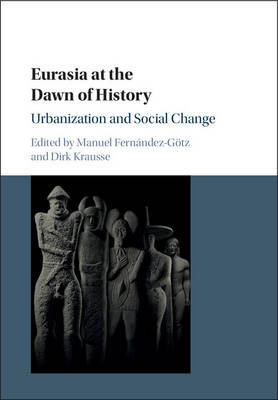
Eurasia at the Dawn of History
Cambridge University Press (Verlag)
978-1-107-14740-9 (ISBN)
Our current world is characterized by life in cities, the existence of social inequalities, and increasing individualization. When and how did these phenomena arise? What was the social and economic background for the development of hierarchies and the first cities? The authors of this volume analyze the processes of centralization, cultural interaction, and social differentiation that led to the development of the first urban centres and early state formations of ancient Eurasia, from the Atlantic coasts to China. The chronological framework spans a period from the Neolithic to the Late Iron Age, with a special focus on the early first millennium BC. By adopting an interdisciplinary approach structured around the concepts of identity and materiality, this book addresses the appearance of a range of key phenomena that continue to shape our world.
Manuel Fernández-Götz is Chancellor's Fellow at the School of History, Classics and Archaeology of the University of Edinburgh. He has coordinated the Heuneburg-Project (2011–13) and authored some 100 publications on Iron Age societies, the archaeology of identities, and the Roman conquest. Key books include Identity and Power: The Transformation of Iron Age Societies in Northeast Gaul (2014) and Paths to Complexity: Centralisation and Urbanisation in Iron Age Europe (2014). He currently directs excavations at the Oppidum of Monte Bernorio in Northern Spain. Dirk Krausse is Head Archaeologist of Baden-Württemberg and Professor at the University of Tübingen. He has directed excavations at the Oppidum of Wallendorf and the 'princely sites' of Mont Lassois in Central France and the Heuneburg in Southern Germany. Among his books are Hochdorf III. Das Trink- und Speiseservice aus dem späthallstattzeitlichen Fürstengrab von Eberdingen-Hochdorf (1996) and Eisenzeitlicher Kulturwandel und Romanisierung im Mosel-Eifel-Raum (2006).
Part I. Between Myth and Logos: 1. Materialities of complexity in ancient Eurasia Manuel Fernández-Götz and Dirk Krausse; 2. Cognitive archaeology and the making of the human mind Colin Renfrew; 3. History of writing, history of rationality David Olson; 4. The impact of social differentiation on identity: lights and shadows of the individualization process Almudena Hernando; 5. The Neolithic conquest of the Mediterranean Jean Guilaine; 6. Low-density urbanism: the case of the Trypillia group of Ukraine John Chapman and Bisserka Gaydarska; 7. From the Neolithic to the Iron Age – demography and social agglomeration: the development of centralized control? Johannes Müller; 8. Early state formation from a big history point of view Fred Spier; 9. Reframing ancient economies: new models, new questions Gary Feinman; 10. How can archaeologists identify early cities? Definitions, types, and attributes Michael E. Smith; 11. Towns between de-territorialisation and networking: on the dynamics of urbanization in the global context Hans-Peter Hahn; Part II. Ancient Civilizations at the Turn of the Axis: 12. Egypt in the 'axial age' Jan Assmann; 13. Conservative vs innovative cultural areas in the Near East Mario Liverani; 14. Elite burials in first-millennium BC China: towards individualization Alain Thote; 15. Giant tumuli of the Iron Age: tradition – monumentality – knowledge transfer Svend Hansen; Part III. Times of Connectivity: The Mediterranean on the Move: 16. Agency, structure, and the unconscious in the longue durée John Bintliff; 17. Phoenicians abroad: from merchant venturers to colonists María Eugenia Aubet; 18. Spheres of interaction: temperate Europe and the Mediterranean world in the Iron Age John E. Collis; Part IV. Early Urban Cultures from South to North: 19. The determinacy of space and state formation in archaic Greece Jonathan M. Hall; 20. Intercultural networks and urbanization in Southern Italy in the early Iron Age Massimo Osanna; 21. Power and place in Etruria Simon Stoddart; 22. Urbanization processes and cultural change in the early Iron Age of Central Europe Manuel Fernández-Götz and Dirk Krausse; 23. Founding rituals and myths in the Keltiké Martín Almagro-Gorbea; Part V. Changing Symbols, Changing Minds?: 24. Phase transition, axial age, and axis displacement: from the Hallstatt to the La Tène culture Rudolf Echt; 25. Early Celtic art in context Otto-Herman Frey; 26. Images, ornament, and cognition in early La Tène Europe: a new style for a changing world Peter S. Wells; 27. The network genesis of the La Tène cultures: a western point of view Pierre-Yves Milcent.
| Erscheinungsdatum | 23.04.2017 |
|---|---|
| Verlagsort | Cambridge |
| Sprache | englisch |
| Maße | 185 x 260 mm |
| Gewicht | 1090 g |
| Themenwelt | Geisteswissenschaften ► Archäologie |
| Geschichte ► Allgemeine Geschichte ► Vor- und Frühgeschichte | |
| ISBN-10 | 1-107-14740-9 / 1107147409 |
| ISBN-13 | 978-1-107-14740-9 / 9781107147409 |
| Zustand | Neuware |
| Haben Sie eine Frage zum Produkt? |
aus dem Bereich


